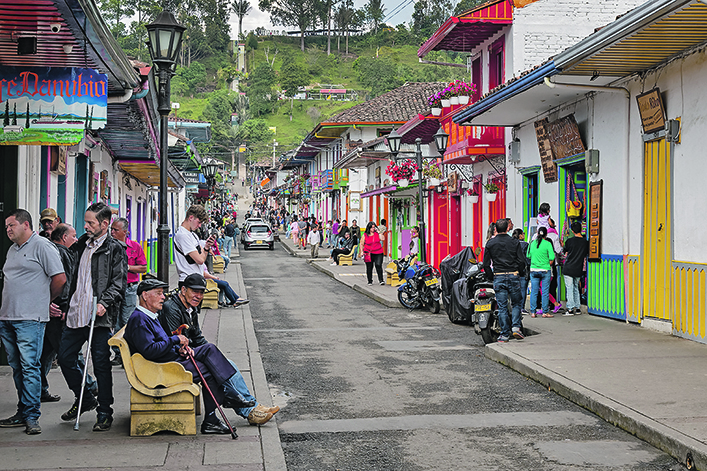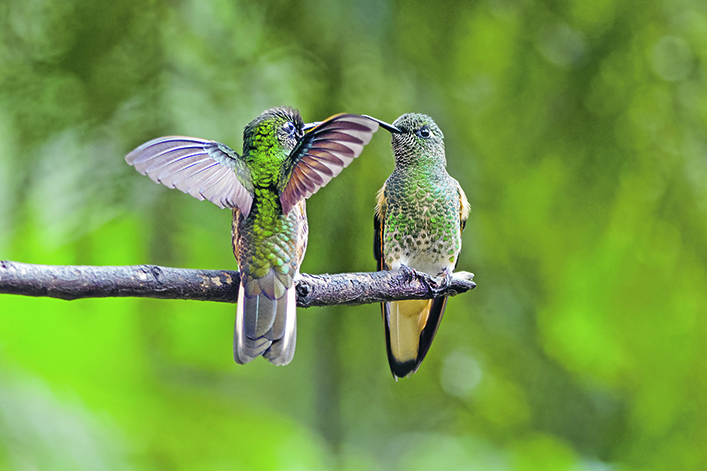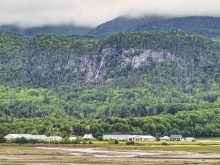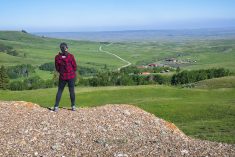If you like palm trees, the imposing Andean wax palms are in a class by themselves — close to 70 metres or 200 feet high — the tallest in the world. But unlike most palms lining tropical coastlines, these grow high in the mountains. It was seeing photos of these impressive though peculiar trees that first made want us to visit this part of Colombia. When we arrived, we found that cool-looking trees were only part of the region’s appeal.
The trees grow in the Cocora Valley near Salento, a small town that ranks among Colombia’s top tourist destinations. With a pleasant rural setting amid Colombia’s coffee-growing region and surrounded by breathtaking scenery, Salento is considered one of the safest parts of the country to visit.
The town of 7,000 is famous for its wildly colourful buildings, making houses in our part of the world look downright drab. It’s not unusual to see red, yellow, green, blue, and orange all appear on the same wall. On some streets it seemed that adjoining buildings competed for attention with outlandish hues.
A fondness for colour extends to nature as well. We stayed at a guest house on the edge of town where the large yard and garden back onto hills and forest. They had a few feeders that attracted an amazing number of birds, not surprising since Colombia has more species than any country in the world. Some were so brilliant that they looked as if they had been dipped in paint.
Coffee shops, many with sidewalk tables and on-site bakeries, line the centre square and adjoining streets. They are always busy since Colombians drink coffee all day long. More than merely a drink, coffee is an integral part of Colombia’s identity. UNESCO even placed the Coffee Cultural Landscape of Colombia on the World Heritage List, recognizing this region as a unique landscape that is both productive and sustainable. Farming practices work in harmony with the mountain forest, and strong local traditions are passed on through generations.

The centre square is filled with Jeeps, many dating as far back as the 1950s, carefully restored and of course, painted in eye-catching shades. While practical and popular in the mountains, Jeeps in the square are used for public transport to nearby communities and to shuttle visitors to the Cocora Valley, a half-hour away.
Cocora Valley is preserved in a park. Guided walks or horseback trips are offered, but like most visitors, we just took the Jeep shuttle to the park and wandered on our own. The main hiking route loops along mountain slopes and through scenic valleys, with non-stop views.
The giant palm trees look even more imposing up close. The wax palm is the national tree of Colombia, its images used on the country’s currency and postage stamps. The tree gets its name from a waxy coating on the trunk that years ago was used for making candles. It takes 50 years for a tree to reach maturity and it might live for 200 years.
The hills are an almost unreal emerald green, a hint that it rains a lot. The weather was much the same each day we spent in this area. Mornings were usually bright and sunny, with fog arriving late afternoon, then inevitable rain soon after.

A longer, more demanding hiking trail goes farther into the hills and forest, which we decided to save for the next day when we could get an early start to make best use of the weather. We began by crossing hillside pastures with grazing cattle, then followed a river valley deeper into the forest. The trail zigzagged from one side of the small river to the other, using rickety suspension bridges that have seen better days. At least they weren’t very high.
Our destination was a small farm high in the hills, which is also a hummingbird reserve. We were greeted with hot chocolate when we arrived, then spent more than an hour mesmerized by the phenomenal bird activity. Colombia has more than 160 different hummingbirds, close to half of the world’s species. The non-stop activity at feeders at the farm gave us a rare chance to watch and photograph them at close quarters.
With no surprise, a steady rain marked our walk back, as the path became increasingly muddy. We kept reassuring ourselves that this was a good thing, that without the rain we couldn’t enjoy the resplendent green scenery.
Arlene and Robin Karpan are well-travelled writers based in Saskatoon. Contact: travel@producer.com.
















